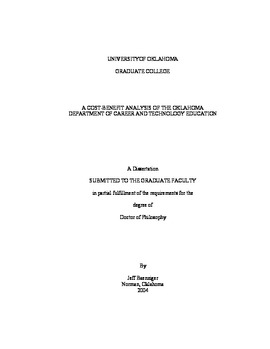| dc.contributor.advisor | Maiden, Jeffrey, | en_US |
| dc.contributor.author | Baenziger, Jeff. | en_US |
| dc.date.accessioned | 2013-08-16T12:19:33Z | |
| dc.date.available | 2013-08-16T12:19:33Z | |
| dc.date.issued | 2004 | en_US |
| dc.identifier.uri | https://hdl.handle.net/11244/800 | |
| dc.description.abstract | As educational policy-makers attempt to allocate scarce resources among competing educational options they face the problem of a lack of quality quantitative research to assist in the process. The purpose of this study was to contribute to the existing educational literature by performing a high quality cost-benefit analysis and comparison of wages across demographic groups within career/technical institutes by analyzing the Oklahoma Department of Career and Technical Education. The Oklahoma CareerTech system was analyzed for FY 1999, 2000 and 2001. Utilizing the ingredients method and a 17% tax rate, total system costs and cost per full-time equivalent (FTE) student were estimated. In FY1999 total system costs were $398.591 million with a cost per FTE of $11,430. In FY2000 total system costs were $400.940 million with a cost per FTE of $12,115. In FY2001 total system cost were $431.194 million with a cost per FTE of $13,789. Economic benefits were estimated by comparing the lifetime tax payments of CareerTech system completers with those holding the next lower academic credential, the high school diploma and/or equivalent. Tax comparisons were estimated at the 5, 17, and 29% tax rates across multiple age, gender, and ethnic groups. Wage data for the CareerTech completers were taken from 1-year follow-up salary surveys as provided by the CareerTech system. High school diploma comparison data were taken from the U.S. Census Bureau's 2000 census, 2001 Current Population Study, and 2002 Current Population Study (U.S. Census Bureau, 2004). The results of the cost-benefit analysis reported net benefit, benefit-cost ratios, and rate of return estimates. In FY1999, from a national perspective, the net benefit was -$45,239 with a benefit-cost ratio of -2.96 and a rate of return of -3.96. In FY2000 the net benefit was -$47,069 with a benefit-cost ratio of -2.89 and a rate of return of -3.89. In FY2001 the net benefit was -$52,654 with a benefit-cost ratio of -2.82 and a rate of return of -3.82. Demographic wage comparisons indicated a statistically significant difference in wages based upon gender and ethnicity. No significant interaction effects between gender and ethnicity were found. | en_US |
| dc.format.extent | ix, 145 leaves : | en_US |
| dc.subject | Oklahoma. Dept. of Career and Technology Education. | en_US |
| dc.subject | Vocational education Oklahoma Cost effectiveness. | en_US |
| dc.subject | Education, Vocational. | en_US |
| dc.subject | Education, Finance. | en_US |
| dc.subject | Political Science, Public Administration. | en_US |
| dc.title | A cost-benefit analysis of the Oklahoma Department of Career and Technology Education. | en_US |
| dc.type | Thesis | en_US |
| dc.thesis.degree | Ph.D. | en_US |
| dc.thesis.degreeDiscipline | Department of Educational Leadership and Policy Studies | en_US |
| dc.note | Adviser: Jeffrey Maiden. | en_US |
| dc.note | Source: Dissertation Abstracts International, Volume: 65-09, Section: A, page: 3284. | en_US |
| ou.identifier | (UMI)AAI3148886 | en_US |
| ou.group | Jeannine Rainbolt College of Education::Department of Educational Leadership and Policy Studies | |
